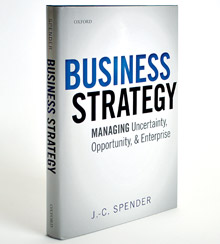Best Business Books 2014: Strategy
To the Nimble Go the Spoils
J.-C. Spender
Business Strategy: Managing Uncertainty, Opportunity, and Enterprise
(Oxford University Press, 2014)
Sanjay Khosla and Mohanbir Sawhney
Fewer, Bigger, Bolder: From Mindless Expansion to Focused Growth
(Penguin Portfolio, 2014)
John P. Kotter
Accelerate: Building Strategic Agility for a Faster-Moving World
(Harvard Business Review Press, 2014)
Notwithstanding all the carefully plotted doctoral dissertations, countless hours of research, and contentious discussions among serious management thinkers, strategy boils down to three fundamental questions: First, how can you differentiate yourself from the competition in the way you create value? Second, what capabilities do you have that are distinct from those of your rivals and essential to your particular way of creating value? Third, what businesses should you be in, and what products and services should you offer, given your chosen approach to creating value and your particular set of distinctive capabilities?
Most companies fail to fully answer these questions—particularly in a fashion that views them as an integral whole. This leaves leaders without guideposts to navigate the most pivotal challenges of corporate management, including transformation, change, agility, and invention. As a result, instead of growth and innovation, there is only incoherence and inefficiency.
Take, for example, eBay’s acquisition of Skype for US$2.6 billion in 2005. With this deal, eBay hoped to become more than an e-commerce company; it wanted to become a global networking player. But eBay’s particular online capabilities and buttoned-down, transaction-heavy culture were ill equipped to assimilate a company in the voice telecommunications market. Moreover, it was unclear how eBay’s approach to marketplace differentiation complemented Skype’s, and vice versa. Five years later, after writing down nearly $1 billion in losses, eBay sold Skype.
EBay’s error was an all-too-common one: Corporate executives often conflate strategy with vision, mission, purpose, plans, or goals. Although these elements may help to focus, inspire, mobilize, and challenge an organization, they are not substitutes for a logical, articulated strategy, and they often lead to helter-skelter corporate development.
So it is also with many business books that are supposed to be about strategy. In lieu of actually discussing the subject, they frequently tiptoe around it. Nonetheless, several books released during the past year offer unique ideas and new thinking for how strategy can help businesses continually innovate, execute, and maintain the dexterity needed to anticipate and outpace competitive challenges and market disruption. Each is practical and simple without being simplistic, and offers convincing evidence for its core premise.
Innovative Strategy
In Business Strategy: Managing Uncertainty, Opportunity, and Enterprise, J.-C. Spender takes what he calls the “entrepreneurial” path to corporate growth and market response. To the peripatetic business professor and retired dean of the School of Business & Technology at SUNY/Fashion Institute of Technology, strategy is the product of executive imagination and judgment, not just logic; the strategy process involves balancing the known, the unknown, and the unknowable. The purpose of strategic analyses, frameworks, and methods is to inspire inventiveness and inform judgment.
Spender arrives at this position by comparing the quantitative planning techniques popular in organizations after World War II—which were mostly developed by the military during the war—with the more subjective, less rigid strategic methodologies that appeared in the 1980s and that are now widespread in the business world. In the earlier era, the dominant idea was to match a firm’s resources to the market’s demands. The company’s business model was tailored to customer needs, suppliers’ offerings, labor availability, logistics, and the like. If a mismatch occurred, the resulting inefficiencies would reduce profit and threaten the firm’s survival.
By contrast, explains Spender, the modern strategy process must be a much more forward-looking activity, because efficiency is no longer enough to deliver a decisive strategic advantage in many industries; instead, a so-called monopoly-based strategic advantage is needed. He cites Apple’s dominance of the tablet business to illustrate the overwhelming necessity of innovation as a means of securing sustainable, above-normal profits, “especially where the ‘windows of competitive advantage’ seem to be opening and closing with increasing speed.”
Business Strategy does an extremely thorough job of surveying the consulting tools and academic economic models and theories available to corporate strategists. The book describes in some detail the salient facets of the most essential methodologies and concepts, including SWOT, Porter’s five forces, the experience curve, the balanced scorecard, the value chain, horizontal and vertical integration, and more. But again and again, Spender returns to the notion that companies must avoid letting these tools stymie their flexibility by over-objectifying decision making. Ultimately, he argues, added value stems from the strategist’s choices—the entrepreneur’s imagination and judgment—not from reams of analysis or data-based conclusions.
By way of example, Spender compares two strategic milestones: IBM’s decision in the 1940s to turn down the patents and processes for electrophotography developed by Chester Carlson, which became the basis of the Xerox machine, and Intel’s ceding of the DRAM market to low-cost Japanese competitors in the 1980s in order to focus on microprocessors. Based on market conditions at the time, IBM believed the customer base for electrophotography was too small and chose to sit on the sidelines; Intel, meanwhile, decided it could build a monopolistic position in microprocessors when neither the market potential nor the manufacturing challenges were well understood. In Spender’s view, IBM hewed to the safety of the known to its detriment, whereas Intel rode the wave of strategic risk by using data analyses as the basis of a calculated leap into the unknown and unknowable.
Spender devotes a chapter in the book to the role of executives in communicating the organization’s strategy to employees so that it is effectively executed. And although he delves deeply into a variety of techniques for disseminating a company’s strategic program (rhetorical, formal and informal, group and individual), he concedes that if successful strategies—and, indeed, successful companies—are built on imagination, motivating people to collaborate requires equally inspired approaches. As Spender advises: “The rhetorical practice that shapes the creative actions of others is precisely what makes the modern firm possible.”
Executives will ignore at their peril the fundamental message of Business Strategy: Once-popular mechanistic planning methodologies no longer work; they have been replaced by innovation-based models that demand flexibility and creativity. A choice to use anything less, Spender argues, is the precursor of corporate atrophy.
The Opportunity Landscape
In Fewer, Bigger, Bolder: From Mindless Expansion to Focused Growth, Sanjay Khosla, former president of Kraft Foods’ developing markets unit, and Mohanbir Sawhney, director of the Center for Research in Technology and Innovation at the Kellogg School of Management, propose a framework for sustainable growth. Called Focus7, it consists of seven steps that begin with searching for growth and end with measuring and communicating progress.
Developing strategy (or picking your bets, as the authors call it) is the second step of Focus7, and it entails navigating the “opportunity landscape.” This methodology has four dimensions, each with two lenses: (1) what you offer, with brand and product lenses; (2) who you serve, with customer and partner lenses; (3) where you go to market, with channel and market lenses; and (4) how you operate, with monetization and process lenses.
Along the way, the authors provide apt examples, making this step refreshingly tangible. For instance, regarding the customer lens, Khosla and Sawhney aver that Enterprise Rent-A-Car’s number one position (by revenue) in its category is based on the company’s unique and relentless emphasis since 1957 on addressing a specific consumer problem—the need for a replacement car. While Enterprise’s competitors bloodied each other at the airports, Enterprise opened more than 5,000 outlets in neighborhoods across the U.S. to furnish autos to local people whose vehicles were being repaired or who didn’t own a car, but needed one for a special occasion.
Although entertaining and informative, this section, like much of the principal argument in the book, avoids a coherent discussion of strategy itself. Presumably, a good strategy is the product of a “focused” set of bets, whereas a bad strategy results from a “mindless” one. It’s hard to argue with this view of the difference between good and bad strategies, chiefly because it is a tautology. This weakness aside, the notion of an opportunity landscape does provide the basis for a higher-level strategy debate in which all companies must engage to succeed. And the authors present a useful series of ideas to explore in assessing your company’s performance and prospects.
What most intrigued me about Fewer, Bigger, Bolder—and what makes it well worth adding to your reading list—are Khosla’s in-depth anecdotes about how he altered the fortunes of the Kraft units he led. In those sections, the book takes on a fly-on-the-wall quality, providing a valuable insider and, yes, strategic perspective of an executive’s thought processes as he effectively manages a turnaround.
When Khosla joined Kraft in 2007, the company had expanded wildly into international markets, but its earnings were coming at a premium. Its sales campaigns lacked discipline, and there was no economic justification for the vast resources that Kraft expended on these efforts. To fix this, Khosla implemented a program known as 5-10-10, under which Kraft’s dozens of product categories, 100-plus brands, and 60-country portfolio were pared down to five strong categories, 10 brands, and 10 markets that the company would focus on and support. Within six years, Khosla’s division tripled its revenue to $16 billion, and profitability grew by 50 percent.
The 5-10-10 buckets were populated through a series of global workshops that represented a substantial shift away from Kraft’s centralized top-down structure—an approach that executive readers hoping to simplify decision making in large organizations should consider emulating. Kraft regional managers, as well as vendors, consultants, investment bankers, and consumers, attended the workshops. Although the agendas were strict, the participants were encouraged to speak freely, share evidence and anecdotes to back up their points of view, and propose practical solutions. Perhaps most important, and useful from a management perspective, Khosla demanded that the top brass in these meetings, including himself, be muted. “The point is to let the discussion roam without regard to past practices or current favorite initiatives,” the authors say. “Even the body language of the ranking executive can tilt the proceedings and inhibit the openness that’s necessary for best results.”
Khosla’s decentralized approach to the workshops opened up the possibility of more autonomy at the local level throughout Kraft, and regional managers were given greater latitude in decision making and enjoyed greater influence in the organization. This eventually led to the most notable marketing success in Kraft’s recent history. During the 2013 Super Bowl at the New Orleans Superdome, a power outage occurred just after the second half started, and the game was stopped for more than a half hour. Almost as soon as the blackout hit, Kraft’s Oreo marketing team came up with a creative tweet to play off the cookie’s well-known “Twist, Lick, Dunk” campaign: “Power out? No problem. You can still dunk in the dark.”
That short, free ad was retweeted 10,000 times in the next hour, and the publicity that Kraft received for it over the next few days was priceless. The tweet, though, was possible only because the company’s leadership equation had been altered. “The authority to approve the tweet had been pushed down far enough that the decision could be made almost instantaneously,” the authors write.
The description of the international expansion campaign that Khosla put in place is a guide to creative executive decision making that C-suite readers can emulate to their advantage. And, although the definition of strategy is somewhat nebulous in Fewer, Bigger, Bolder, Khosla’s success at Kraft nods at the good things that can happen when strategy and tactics align.
A Structure for Strategic Agility
Accelerate: Building Strategic Agility for a Faster-Moving World, by John P. Kotter, the Konosuke Matsushita Professor of Leadership Emeritus at Harvard Business School, is primarily about the ability to adjust strategy quickly in response to changes in the global business environment. This is a ripe topic for discussion (as well as one in which Kotter, a noted change expert, specializes).
Navigating the tension between maintaining a stable business model that has produced consistent results and embracing reinvention is a difficult challenge for most companies. Strategic stability can be quite rewarding and is the hallmark of great companies such as Wells Fargo, Southwest Airlines, Walmart, and Walt Disney. But there are also many once-dominant companies whose strategies became obsolete faster than they were able to respond to shifting market and competitive conditions—for example, Blockbuster and Research in Motion, two companies cited in Accelerate.
In Kotter’s view, businesses today cannot afford to be complacent. (Can they ever?) Yet he offers a convincing portrait of a typical organization’s life cycle to demonstrate that, despite their best intentions, most companies naturally lose their innovative edge as they evolve. As he depicts it, successful startups have a strong, market-focused vision, delineated initially by the entrepreneur founder. The company is more of a network than a pyramid. At the center is the entrepreneur and his or her closest advisors; linked to them like planets in a solar system are people managing various initiatives, often associated with developing and testing new products and services. At this stage, the organization chart is relatively flat and the company is fluid; a once-promising initiative can be dropped on the fly in favor of a better idea. “This kind of agility can enable a successful young firm to run circles around more mature competitors,” Kotter writes.
Most companies naturally lose their innovative edge as they evolve.
With success, however, come formal processes and a management structure—an operational hierarchy to ensure that the company can satisfy its growing market. At the same time, the original entrepreneurial system does not fade away. The hierarchy and the network coexist to drive efficiency and innovation, respectively. This period, Kotter contends, is extraordinary, marked by widening profits, an excellent culture, and favorable capital markets. Unfortunately, the phase is usually short-lived. As growth escalates, operational needs expand, and before long, the hierarchy, which increasingly controls company resources, begins to dwarf and minimize the network. At the end of this evolution, the company may have a strong market position, great brands, good relations with customers, and economies of scale, but it will have lost its agility and innovative edge. In other words, it is now vulnerable to attack from a nimbler startup.
Given this inevitable progression, Kotter argues, the only way to sustain market share and simultaneously beat the competition into new markets is to re-create the dual operating system that the company had when it was at its best. The left side of the company would consist of the traditional business and its hierarchy; the right side would be populated by a “volunteer army” led by a “guiding coalition” overseeing a dynamic network, free of bureaucratic layers, whose job would be to drive strategic initiatives that would stall if relegated to the left-side bureaucracy. Kotter’s five principles for forming and managing this network are the accelerators of the book’s title.
To support his point of view, Kotter tells the story of an unnamed B2B technology company whose global market share was tumbling primarily because it lagged behind competitors in Asian expansion and new product development. Within two years of implementing the dual-operating approach, the company experienced a marked turnaround: Annual revenue growth more than doubled, to more than 60 percent, and the company rose from fourth to second in market share. Moreover, the company’s market capitalization ballooned 155 percent, to $10 billion-plus.
Because Accelerate delivers such a potentially valuable message, the fact that it does not address the significance of coherent strategy as a prerequisite for successful innovation creates a big hole. Absent that discussion, it’s unclear, for example, how the right-side network’s purpose—to make strategy and its implementation more agile—is aligned with the company’s strategy itself. Some aspects of strategy, such as pricing the value proposition or changing the portfolio, can be remixed relatively quickly and frequently; but other elements, such as the capabilities that differentiate a business or the types of customers it chooses to target, cannot be altered overnight.
Nevertheless, as a new way of looking at agility and flexibility, Kotter’s thesis is extremely appealing. It presents a valuable course of action that speaks to a particularly challenging conundrum for maturing companies—that is, how to combine the dexterity of the startup years with the knowledge gained from experience. For this reason, I choose Accelerate as the best business book of the year on strategy. It brings much-needed insight as to why big companies struggle with implementing strategic innovation, and it recommends a practical approach to solving that problem. In doing so, it has the potential to bring inside the walls of our most successful enterprises the benefits of creative destruction.
All three books have a lot to offer. Readers who have a solid foundation already in place—especially a clear definition of their strategy in mind before starting page one—will come away from these selections better equipped with practical and compelling ideas to help implement those strategies in the real world.![]()
Reprint No. 00287
Author profile:
- Ken Favaro is a senior partner with Strategy& based in New York. A longtime advisor to business leaders and a co-teacher of a course on strategic innovation at Columbia Business School, he leads the firm’s work in enterprise strategy and finance.





